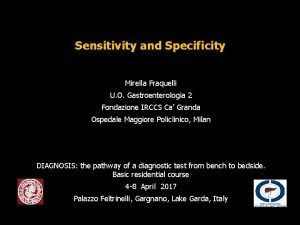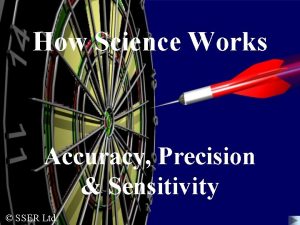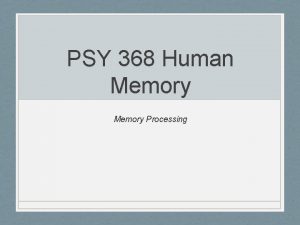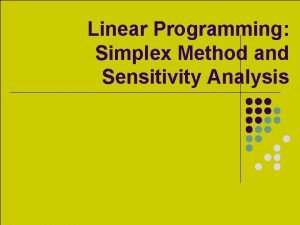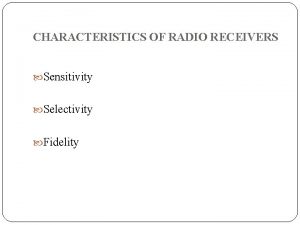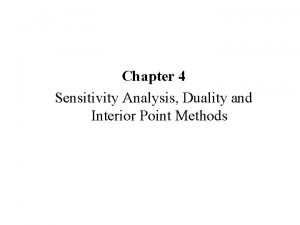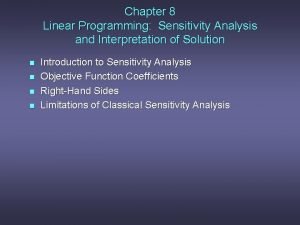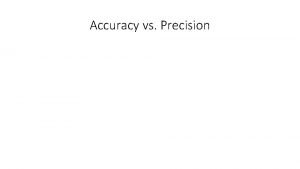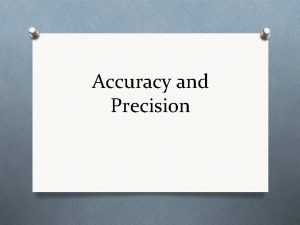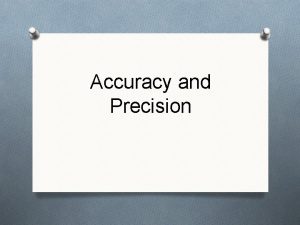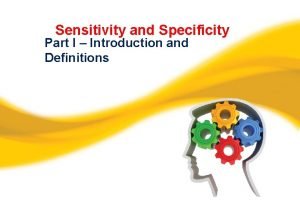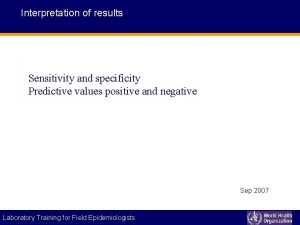Simultaneous Comparisons of Accuracy Sensitivity and Specificity in















- Slides: 15

Simultaneous Comparisons of Accuracy, Sensitivity, and Specificity in Diagnostic Studies with Binary Data Jörg Kaufmann, Ph. D. , Schering AG, Berlin, Germany Suming Chang, Ph. D. , Berlex, New Jersey, USA

Issues which will be addressed l Choice of efficacy measures for the primary endpoint l Multiple evaluations on each patient for the primary efficacy analysis Page 2

Issues which will not be addressed l Imperfect gold standard l Establishing a gold standard l Study design – parallel group, cross-over l Most appropriate image set comparison: Page 3 Ø Post versus pre Ø Post + pre versus pre Ø More than 1 post sequence

More issues which will not be addressed l Approaches to handling uninterpretable or non -assessable images or regions of interest in images l Disease state not binary l Multiple blinder readers and clinical investigator evaluations l By the time the trial is done, technology will have changed Page 4

Data Structure in Diagnostic Imaging Studies Page 5

Two way design Strata Non diseased Diseased T 1 T 2 P 01 P 02 (n 01) (n 02) P 11 P 12 (n 11) (n 12) nsi number of patients/diagnostical units psi proportion of correct results n 0 i ≠ n 1 i in general Clustered data: each patient contributes diseased and non-diseased vessel segments (observational units, correlated) Paired design: each patient received both treatments, T 1 and T 2 correlated Page 6

Indices for Validity Specificity effect in non diseased patients Sensitivity effect in diseased patients T 1 T 2 P 01 P 02 P 11 P 12 T 2 – T 1 Accuracy (overall effect across strata) Psi proportion of correct results in stratum s on treatment i ws is a weight assigned to stratum s, ∑ ws =1 Page 7

Four Commonly Used Weighting Schemes Page 8

Comments on different weighting schemes Page 9 Pool • • CMH • Strata with lager number of patients/vessel segments get more weights • Weights generally yield an approximately unbiased estimate of d • Estimate has a potentially larger variance Prevalence Dependent Definition for accuracy in the regulatory guidelines Usually results in decreased power for inference Simpson’s paradox possible EQUAL • Corresponds to the accuracy index (area under the curve) in the ROC methodology for dichotomous data • Prevalence Independent INVAR • Usually yields an estimate of d with minimum variance. • Weights involve unknown nuisance parameters (estimated from the data, addition random variability)

Example: D. V. Mehrotra (6)pp 1349 Strata Page 10 T 1 T 2 Non diseased 0. 48 0. 530 0 48/100 53/100 Diseased 0. 8 0. 95 1 48/60 57/60 Weighting Scheme W 0 W 1 T 1 w T 2 w w P-value Pool 0. 625 0. 375 0. 688 0. 082 CMH 0. 625 0. 375 0. 688 0. 082 EQUAL 0. 50 0. 64 0. 74 0. 1 0. 031 INVAR 0. 41 0. 59 0. 669 0. 778 0. 109 0. 018

Overall Effect across Strata 1. 00 T 2 0. 90 P 12= 0. 95 T 1 0. 80 P 11= 0. 80 0. 70 0. 60 0. 50 T 1 T 2 P 02= 0. 53 P 01= 0. 48 0. 40 non diseased population CMH EQUAL INVAR total population Page 11 Diseased population

Closed testing with a-priori ordered hypotheses First step: compare the treatments in the total study population T 1 vs T 2 Accuracy across both strata (diseased and non-diseased) (CMH or EQUAL weights for each strata) Proceed to step 2 only if significant result obtained in step 1 Second step: compare the treatments in each sub-population T 1 vs T 2 Accuracy in diseased patient ~ Sensitivity Accuracy in non-diseased patient ~ Specificity Test all 3 hypotheses at the α = 0. 05 level. The closed testing procedures consider the multiplicity aspects. Page 12

Conclusions l Use statistical methods accounted for clustered data l Pre-specify the weighting scheme for the overall accuracy across strata l Pre-specify closed testing principle with a priori ordered hypotheses l Define all above in the study protocol prospectively l Recommend to communicate with the authorities in the early trial design phase Page 13

Thank you for your attention Accuracy in total study population n ty i i v i sit d Sen sease di ient pat in y t i c cifi ased e p S e dis n no atient p Experim Observa ental un tional u it? nit?

REFERENCES 1. Biesheuvel Eghart H. E. , Hothom L. A. : Protocol designed subgroup analyses in multiarmed clinical trials: multiplicity aspects. Journal of Biopharmaceutical Statistics 2003, 13. No 4, pp 663673 2. Kaufmann J. , Werner C. , Brunner E. : Nonparametric methods for analysing accuracy of diagnostic test with multiple readers. Statistical Methods in Medical Research 2005, 14: 129 -146 3. Kaufmann J. , Koch G. G. : Statistical considerations in the design of clinical trials, weighted means and analysis of Covariance. Proceedings of the Conference in Honor of Shayle Searle, Cornell University , Biometrics unit 1996, p 77 -92 4. Liu Aiyi, Schisterman E. F. , Mazumdar M. , Hu Jiong: Power and sample size calculation of comparative diagnostic accuracy studies with multiple correlated test results, Biometrical Journal 2005, 47, 2; 140 -150 5. Maurer W. , Hothom L. A. , Lehmacher W. : Multiple comparisons in drug clinical trials and preclinical assays: a priori ordered hypotheses; Biometrie in der chemisch-pharmazeutischen Industrie 1995, 6; 3 -18; Gustav Fischer Verlag 6. Mehrotra Devan : Stratification issues with binary endpoitns; Drug Information Journal 2001, 35; 1343 -1350 7. Mehrotra Devan , Railkar R. : Minimum risk weights for comparing treatments in stratified binomial trials, Statistics in Medicine 2000, 19; 811 -825 8. Scott P. E. and Campbell G. : Integration of subgroup analyses in medical device clinical trials; Drug Information Journal 1988, 213 -220 9. Shayle R. Searle: Linear models for unbalanced data, John Wiley & Sons, 1987 10. Swets John A. , Pickett Ronald M. : Evaluation of Diagnostic System-Methods from Signal Detection Theory; Academy Press 1982 Page 15
 Spin snout mnemonic
Spin snout mnemonic Sensitivity specificity ppv npv
Sensitivity specificity ppv npv Sensitivity accuracy precision
Sensitivity accuracy precision Levels of processing theory
Levels of processing theory Geometric specificity
Geometric specificity Memory stages model
Memory stages model Amine hormone
Amine hormone Hukum fisiologik
Hukum fisiologik Priori comparisons
Priori comparisons Equality comparative and superlative
Equality comparative and superlative Irregular adjectives comparative and superlative
Irregular adjectives comparative and superlative Comparisons of adjectives and adverbs
Comparisons of adjectives and adverbs Sensitivity analysis linear programming
Sensitivity analysis linear programming The selectivity of a radio receiver is
The selectivity of a radio receiver is Sensitivity analysis and duality
Sensitivity analysis and duality 100% rule sensitivity analysis example
100% rule sensitivity analysis example
